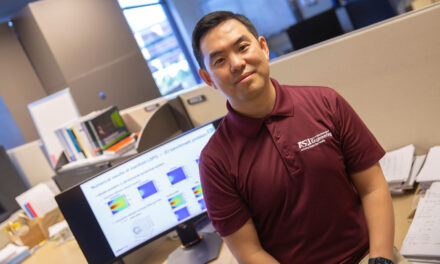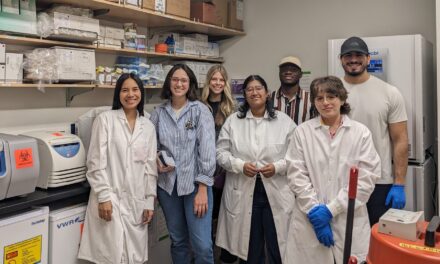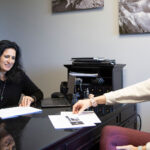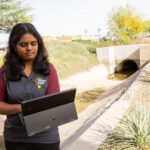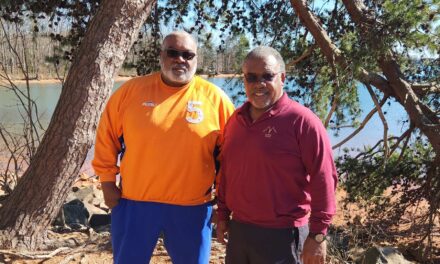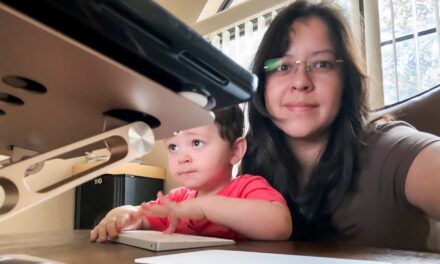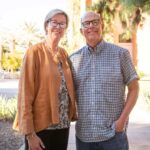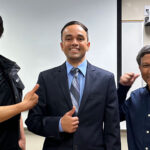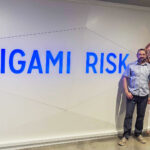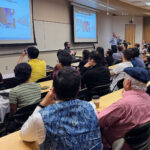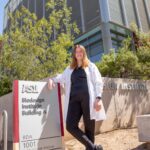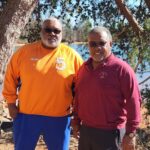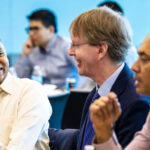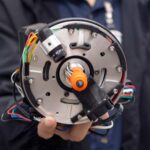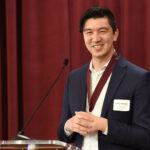
Meet the Fulton Schools’ outstanding graduates of Spring 2018

At the end of each spring and fall semester, the Ira A. Fulton Schools of Engineering takes time to recognize some of the graduating class for their outstanding commitments to both academics and the Fulton Schools at large.
Students selected as Outstanding Graduates are honored for their exemplary academic performance. To qualify, they must graduate with a minimum 3.40 GPA and have participated in major-specific or Fulton Schools activities. Those receiving an IMPACT Award have been singled out for their contributions to the Fulton Schools community in leadership, volunteer and service roles. Recipients must graduate with a minimum 3.25 GPA, and display evidence of their positive impact on our community.
These exceptional students have excelled in research, community service, entrepreneurship and outreach, leaving a lasting and beneficial impact on the Fulton Schools community, Arizona and elsewhere. Many of these graduates have served as extraordinary representatives of ASU through industry internships, volunteer efforts or as ambassadors to communicate the mission of the Fulton Schools and the university as a whole.
Read below about some of our exceptionally bright individuals graduating from the Fulton Schools in Spring 2018:
Outstanding Graduates
HASSAN ALMOUSA
Materials Science and Engineering
Hassan Almousa has big dreams of using science and engineering to help the world. Though he first considered theoretical physics, he found his path in materials science and engineering.
Learn more
BSE in Materials Science and Engineering
Hometown: Dammam, Eastern Province, Saudi Arabia
Graduated from Alhussan Private School
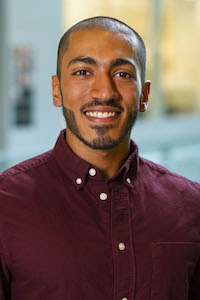 Hassan Almousa has big dreams of using science and engineering to help the world. Though he first considered theoretical physics, he found his path in materials science and engineering.
Hassan Almousa has big dreams of using science and engineering to help the world. Though he first considered theoretical physics, he found his path in materials science and engineering.
“Materials science and engineering is a major where I can equally be a scientist and an engineer,” Almousa says. “It allows me to use theories and concepts as well as synthesize, characterize and build new materials and machines.”
Almousa has researched 2D materials that he believes will “open the door to a future where walls could be smart screens and we can wear devices and sensors on our skin.”
He has also served as president of the ASU chapter of Material Advantage, where he sought to bring industry and students together, create more networking experiences, help members land job offers and organize outreach efforts to get the word out about materials science and engineering opportunities.
The eight-time Dean’s List recipient enjoyed the research experience and lab work he conducted as part of his studies, especially with Professor Nathan Newman.
“Professor Newman had an amazing impact on me regarding the basics of research and group work,” Almousa says. “I learned life lessons and science lessons all the time from him.”
Almousa says he and Newman also share an interest in cars.
“My main hobby is automobile sports and sports cars,” Almousa says. “I love going to car shows and going to race tracks to race cars and watching the Formula One Championship.”
After graduation, Almousa will travel with the AZLoop team to the SpaceX 2018 Hyperloop Pod Competition in July and then start a job in the research and development center of Saudi Aramco, which funded his undergraduate degree.
He also has bigger plans for his future, including getting a master’s degree at King Abdullah University of Science and Technology and later earning a doctoral degree. He hopes to one day build his own consulting company that will solve big scientific and engineering challenges.
“I see my future full of hard work and inspiration, to be a well-rounded person who will make lots of discoveries and lead the world to a better future,” he says. “My dream is to figure out the science behind dark matter and energy, and use it for the benefit of people.”
SAMANTHA BAKER
Informatics
Samantha Baker found challenge and reward in the Fulton Undergraduate Research Initiative, where she used what she’s learned in her informatics major to explore human-robot communication.
Learn more
BS in Informatics
Hometown: Danville, California
Graduated from Monte Vista High School in Danville, California
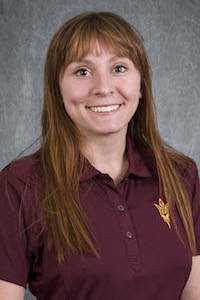 Samantha Baker’s most challenging and rewarding experience as an undergraduate was participating in the Fulton Undergraduate Research Initiative program, where she researched in the lab and presented her work at the FURI Symposium. She studied user reactions to the communications style of a robot, the Nao. She focused specifically on whether the realism of a humanoid robot’s nonverbal communication impacts a user’s perceptions of its friendliness and likability.
Samantha Baker’s most challenging and rewarding experience as an undergraduate was participating in the Fulton Undergraduate Research Initiative program, where she researched in the lab and presented her work at the FURI Symposium. She studied user reactions to the communications style of a robot, the Nao. She focused specifically on whether the realism of a humanoid robot’s nonverbal communication impacts a user’s perceptions of its friendliness and likability.
“The whole experience was so empowering,” says the New American Scholarship recipient.
Baker’s first exposure to robotics was in high school, where she was a member of a FIRST Robotics competitive team. Following completion of the FURI project, Baker’s mentor, Assistant Professor Erin Walker, invited her to continue doing research in her lab.
“Dr. Walker encouraged me to pursue a master’s degree,” Baker said. “She helped me to think more highly of myself by setting her expectations high.”
Baker’s father is an engineer and she was exposed to the many opportunities in the field, but she hadn’t decided where to focus until she learned about informatics. Informatics unites advanced technology with engineering principles to solve problems.
“I think that’s why Informatics is such a good fit for me,” she says. “I have a diverse skillset that I can use to take a number of different paths.”
In the fall Baker will move to Seattle to begin the master’s degree program in human-computer interaction and design at the University of Washington. Her advice to students: “apply for everything.”
“Every time you see an opportunity that looks interesting, throw your résumé on the pile,” she says. “Ignore the voice in your head that’s saying you’re not good enough or not experienced enough or not the right fit.” You will learn to handle rejection, she counsels. But, “sometimes, when you least expect it, you end up with an amazing internship, job or research opportunity you’d never have landed by being shy.”
NICOLE BILLINGSLEY
Technological Entrepreneurship and Management
Nicole Billingsley’s long-term goal is “to fully leverage my knowledge in operations management in order to continue to ensure that the needs of our patient populations are in the forefront of our minds at all times.”
Learn more
BS in Technological Entrepreneurship and Management
Hometown: Angola, Indiana
Graduated from Prairie Heights Senior High School
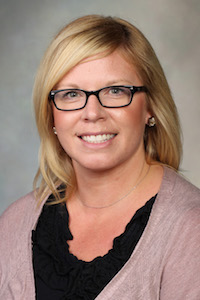 Nicole Billingsley worked full time at Mayo Clinic while she was also a full-time student at the Ira A. Fulton Schools of Engineering — a daunting achievement, but possible for someone with a clear focus.
Nicole Billingsley worked full time at Mayo Clinic while she was also a full-time student at the Ira A. Fulton Schools of Engineering — a daunting achievement, but possible for someone with a clear focus.
“It was always clear that my future included healthcare and a desire to effectively ‘be the good’ in this world,” she explained.
She started in a nursing program, but very soon realized that operations management and not direct patient care was what she wanted.
“This decision to change my focus, albeit difficult to arrive at initially, was one of the best decisions of my life,” she said. “I’m now 100 percent certain that I’m on the right path.”
Billingsley is a patient support supervisor in the cardiovascular diseases unit at Mayo Clinic.
“As an individual who innately questions and primarily focuses on the process, a degree in operations management made sense,” she said.
She said that an engineering mindset combined with her passion for healthcare will help her positively impact the lives of patients, providers and allied health staff. A leader of day-to-day operations at a healthcare facility, she hopes to assure that the focus is on best practices, including fiscally responsible reform, while remaining open to change and maintaining interdisciplinary collaboration, integrity and an ongoing commitment to education.
In July she starts at Grand Canyon University, where she will pursue both the Master of Business Administration and Master in Leadership degrees.
Her advice to other students: it’s never too late to do what you were meant to do.
“While it is inevitable that life will get in the way at some point, don’t allow yourself to lose sight of those things that help you to shine,” she said.
JUSTIN BLOMMER
Biomedical Engineering
Justin Blommer had big aspirations that didn’t fit with his small-town upbringing. ASU helped him meet his goals of living somewhere far away, meeting new people and studying at the intersection of science and medicine.
Learn more
BSE in Biomedical Engineering
Hometown: Chatfield, Minnesota
Graduated from Chatfield High School
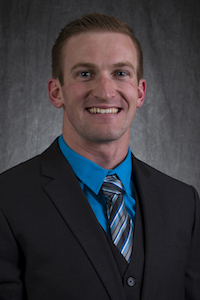 Justin Blommer had big aspirations that didn’t fit with his small-town upbringing.
Justin Blommer had big aspirations that didn’t fit with his small-town upbringing.
“I grew up in a small town in Minnesota and wanted to go to a big school that was far away from home for the opportunity to live somewhere new and meet lots of new people,” Blommer says.
ASU met that requirement and biomedical engineering was an easy choice for his specific path at the university.
“Growing up near Rochester, Minnesota — the heart of Mayo Clinic — I had lots of family and friends who worked in health care,” Blommer says. “I found biomedical engineering to be a really cool combination of science and medicine and decided to pursue my education in this program.”
After arriving at one of the largest university campuses in the country, Blommer met many new people and formed rewarding relationships.
Fulton Schools faculty member Casey Ankeny was one such person who made his ASU experience great. Though the courses she taught were difficult, she made them easy to follow.
“Casey made all of the homework and exam problems relevant to real-world problems and solutions, which made them fun to work through,” he says. “These experiences instilled my passion for engineering.”
He wrapped up his undergraduate studies with a Fulton Undergraduate Research Initiative program-funded senior capstone project developing a foreign body extraction device for use in gastroenterology procedures. He and his team submitted the design for a provisional patent application through Skysong Innovations.
After Blommer earns a bachelor’s degree and completes additional master’s level classes as part of the accelerated 4+1 program, he will then head to the University of California, San Diego to earn his master’s degree of engineering in bioengineering in the fall. This summer he will return to his summer internship at Jump Simulation in Peoria, Illinois.
“I am working on a team in health care analytics on a project that strives to improve the efficiency of hospital operations,” says the recipient of the Arizona Veterans Hall of Fame Society Copper Lamp of Knowledge Award and Veterans Education Fund Scholarship.
Outside of engineering, Blommer loves powersports — “anything with a motor that can go off road.” He’s especially passionate about motorcycles.
“Any weekends I have free time I’ll take riding trips up into the mountains.”
IAN BRENNER
Technological Entrepreneurship and Management
Growing up, Ian Brenner was surrounded by people who were fascinated by design and challenged him with ideas.
Learn more
BSE in Technological Entrepreneurship and Management
Hometown: Franklin Lakes, New Jersey
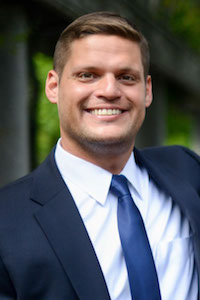 Ian Brenner has a passion for making change. His goal: “invent, scale, repeat beautiful artifacts through the progression of science, technology and art.”
Ian Brenner has a passion for making change. His goal: “invent, scale, repeat beautiful artifacts through the progression of science, technology and art.”
Growing up, Brenner was surrounded by people who were fascinated by design and challenged him with ideas. His grandfather was his “engineering idol” who taught him to push back at conventional thinking. His father, an orthopedic surgeon and founder of Diagnostic Lab Corporation, is credited with the advancement of new surgical techniques and was past medical director of ADM Tronics. There, Brenner got to know and work alongside scientist and inventor Alfonso DiMino.
He is currently working on the creation of personalized medicine regimes using cannabinoids and the production of alternative energy based on blueprints designed with DiMino. He chose the Technological Entrepreneurship and Management program because of its focus on preparing innovators.
“I wanted a degree that would allow me to create the things I dream about and fascinate me, and a STEM degree, particularly in tech entrepreneurship, was the closest thing available to help build a foundation for that future,” Brenner said. “With a ‘choose your own adventure’ framework — in my case focused on product design, management and entrepreneurship — the foundation is laid for true disruption.”
Brenner advises future students to take time off if necessary to figure out what they want to do in life.
“Go out and find something you love and then come back and explore that passion in an environment designed to challenge you,” he said. “Do not waste your time and money chasing someone else’s goals. If you can keep that in mind while being realistic, you will be light years ahead of most who chase a piece of paper without passion.”
An outdoorsman, Brenner feels most comfortable on the ocean or in the mountains, but in the next year he will focus on pursuing a master’s degree.
MICHELLE CAPRILES-ESCOBEDO
Software Engineering
Michelle Capriles-Escobedo dreams of owning a non-profit or business that uses technology to make a social impact.
Learn more
BSE in Software Engineering
Hometown: Gaithersburg, Maryland
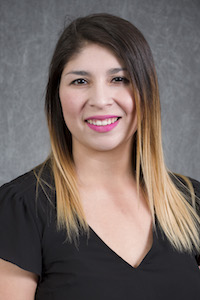 Michelle Capriles-Escobedo dreams of owning a non-profit or business that uses technology to make a social impact.
Michelle Capriles-Escobedo dreams of owning a non-profit or business that uses technology to make a social impact.
“I see technology as a great vessel for connecting people from polar backgrounds to increase understanding of each other,” she says. “I am particularly interested in improving the quality and access of education, improving resources for and awareness of mental health, and mitigating the gaps in opportunities and resources in between communities of varying wealth.”
Capriles-Escobedo was going to school part-time as an online student during her first year at ASU when she realized software engineering was the right career path for her.
“I was working full-time for a research department at ASU, where my tasks varied widely,” she says. “I noticed that even when I was fatigued, I never got bored of programming and my interest in it only grew. I figured if I could program and enjoy it even when I was tired, I could feel secure in pursuing this as a career.”
Getting involved in the Software Developers Association, also known as SoDA, is where her experiences at ASU really took off. As a junior, she was the marketing committee lead and director of communications for SoDA. She was then elected President for the next year, and in SoDA managed a team of 20 officers and introduced four new initiatives to develop a deeper sense of community within members.
“I really enjoy being connected with other students with similar interests and drive,” she says. “I progressively increased my involvement because I’ve found that working with other students with similar goals as me is very motivating and I’m now part of a supportive community of people that I have learned a lot from.”
Her work in SoDA didn’t go unnoticed.
“I was recruited to be director of marketing for Southwest Hacks,” she says. “I built a team of 10 people from scratch and together we got over 400 students to attend, which is a lot for a first-time hackathon. A lot of work went into putting together what was a really big hackathon, and as much work and stress as it was, seeing it succeed made it all worth it. I would label it as one of the best weekends of my life.”
After graduation Capriles-Escobedo will be working at Qualtrics in Seattle, Washington, as a software engineer starting in July 2018.
PAM COLEMAN
Human Systems Engineering
No fewer than four faculty members Pamela Coleman got to know soon after starting college told her she would be a perfect fit for human systems engineering.
Learn more
BSE in Human Systems Engineering
Hometowns: Medina, Ohio, and Gilbert, Arizona
Graduated from Gilbert High School
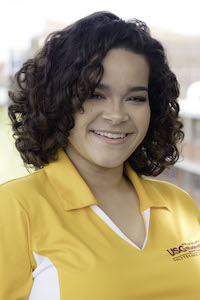 No fewer than four faculty members told Pamela Coleman that she would be a perfect fit for human systems engineering.
No fewer than four faculty members told Pamela Coleman that she would be a perfect fit for human systems engineering.
They were right. After switching majors, her passion for the emerging field that combines systems engineering, technology and psychology “has grown immensely,” Coleman says now as she plans to continue studies to earn a master’s degree in the discipline.
Throughout her undergraduate years, Coleman says she has found ways “to apply her major to nearly everything she does daily.”
By her sophomore year, Coleman had joined the Undergraduate Student Government at ASU’s Polytechnic campus. She started as an intern, moved up to a senator and then a designated Senate post enabling her to represent her fellow students in ASU’s Barrett, the Honors College.
Her motivation to help lead campus government was “to help improve student’s experience,” an impulse that aligned with what attracted her to human systems engineering.
Beyond exemplary academic performance, Coleman’s accomplishments include securi,ing the services of a certified psychologist for Polytechnic campus students and starting an initiative aimed at finding solutions for student housing, facilities and transportation issues.
Coleman was appointed the campus student government’s first director of Health and Wellness, a position that charged her with the task of promoting physical, mental and sexual health among students.
This semester she planned a campus event for World Health Day on April 7 for students to learn about opportunities and services available to help them maintain their health.
She established another event, known as Poly Gras, (pronounced like the New Orleans Mardi Gras celebration), a party-atmosphere gathering at which students can get to know their student government leaders.
Coleman’s academic abilities and varied extracurricular endeavors earned her support from ASU’s New American University Scholar program and from the Martinson Sustainability Solutions Research Grant Program.
During her off hours, Coleman has trained for more than three years in yoga and meditation, leading her to be selected to teach a stretch group fitness class at the Polytechnic campis student fitness center. She’s also skilled at “the art of makeup” – a talent she acquired “by watching, many, many YouTube videos.”
Beyond her knowledge of humans systems engineering, Coleman says she also considers herself “skilled at yoga” — as well as at “quick planning” and “the art of makeup” — the latter talent acquired “by watching many, many YouTube videos.”
PAULINA DAVISON
Computer Systems Engineering
Paulina Davison was drawn to computer systems engineering because she was interested in circuits and algorithms.
Learn more
BSE in Computer Systems Engineering
Hometown: Puyallup, Washington
Graduated from Governor John R. Rogers High School in Puyallup, Washington
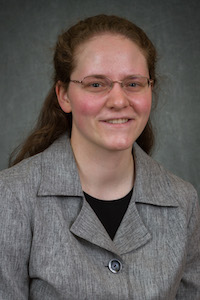 Paulina Davison was drawn to computer systems engineering because she was interested in circuits and algorithms.
Paulina Davison was drawn to computer systems engineering because she was interested in circuits and algorithms.
“I wanted to learn the physical properties and abstract structures that support our digital reality and saw that the computer systems engineering path aligned with this,” says the Barrett, The Honors College student.
She has used technology to make a difference during her time at ASU.
In her honors thesis, she researched the security of smart cars with the Laboratory of Security Engineering for Future Computing, and in her senior-year capstone project with InnovationSpace she worked on an interdisciplinary team to design a closed-loop system for Adidas.
“As part of InnovationSpace we developed a product and service where consumers would donate their old shoes and the donated material would be used to make new city-specific shoes,” she says.
Working with the Center for Embedded Systems, which is directed by one of her mentors, Sarma Vrudhula, she also tested the viability of using an accelerometer to track chest movement for an internet of things device to detect asthma.
“[Vrudhula] has consistently believed in my ability and supported me as a researcher and as an individual,” Davison says. “He inspires me.”
She also completed an internship at Cisco Systems in the company’s Security Implementation Services.
A seven-time Dean’s List student, Davison earned the National Merit Scholarship, the New American University Scholarship, the Motorola Embedded Systems Scholarship and the Andy Grove Intel Scholarship.
Outside of academics, Davison was involved in many clubs and student activities, including serving as industry outreach chair for the Software Developers Association (SoDA), twice attending the Grace Hopper Celebration of Women in Computing and earning the “Most WOW project!” award at Hack Arizona.
Davison, a Citizen Potawatomi Nation citizen who has earned the Nation’s Tribal Scholarship 10 times for academic excellence, also served as vice president of the Barrett Indigenous Culture Association (BICA). In this position she worked with other student leaders to promote the culturally diverse community at Barrett and ASU. Their work earned the club the Best Recurring Program Award and Most Collaborative Student Organization Award from the American Indian Council for the 2016–2017 academic year.
The high-achieving engineer and student organization leader also made time to pursue her passion for music. She played the French horn in ASU’s symphonic ensembles and earned a French Horn Performance Talent Award from ASU.
AMBER DRAINA
Graphic Information Technology
Amber Draina never backs away from a challenge. She’s managed several jobs, a full class schedule and student club involvement — all while raising a two-year-old.
Learn more
BS in Graphic Information Technology
Minor in Human Systems Engineering
Hometown: Mesa, Arizona
Graduated from Desert Hills High School in Gilbert, Arizona
 Amber Draina, a graphic information technology major at Arizona State University, never backs away from a challenge. She’s managed several jobs, a full class schedule and student club involvement — all while raising a two-year-old.
Amber Draina, a graphic information technology major at Arizona State University, never backs away from a challenge. She’s managed several jobs, a full class schedule and student club involvement — all while raising a two-year-old.
“I’ve grown as a person and pushed myself to become a great leader,” said Draina, who’s also pursuing a minor in human systems engineering. “It meant many nights of only a few hours of sleep, but it was all worth it. I learned the value of time management and strengthened my dedication to earn my degree.”
Christina Carrasquilla, a lecturer of graphic information technology, has mentored Draina since early on in the program. Carrasquilla invited Draina to become an undergraduate teaching assistant and encouraged her to join AIGA Poly, a student organization focused on design and technology.
“Carrasquilla has definitely helped me grow as a student and as a leader,” said Draina, who grew up in Gilbert, Arizona. “She encouraged me to get involved in a leadership role, which has given me so much experience and confidence to succeed in my professional life.”
Draina has been the president of AIGA Poly for almost two years. The organization creates design solutions for clients in the community and at ASU. In 2017, they won an award for the best demonstration of community embeddedness at the Student Organization Awards and Recognition Ceremony.
“The most rewarding aspect about my experience at ASU has been the great friendships I’ve made through being involved with so many activities,” she said.
In the fall, Draina will start her master’s degree as part of a 4+1 accelerated program. She’ll focus on the business and marketing side of the industry, while working as a UX tester at ASU’s Enterprise Marketing Hub. Eventually, she wants to be a creative director who helps smaller non-profits with marketing.
ERIN GLAVIN
Industrial Engineering
Erin Glavin is a strong believer that there are not enough industrial engineers in the world.
Learn more
BSE in Industrial Engineering
Hometown: Bakersfield, California
Graduated from Frontier High School in Bakersfield, California
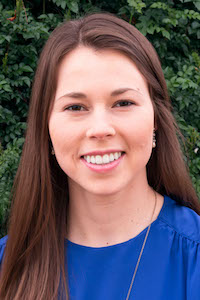
Erin Glavin is a strong believer that there are not enough industrial engineers in the world.
“There is an enormous amount of inefficiencies in a person’s everyday life,” she says. “Eliminating those inefficiencies will provide people with more time to spend with their loved ones and more time to create technologies to benefit the lives of many.”
The Bakersfield, California, native decided to study engineering due to her enjoyment of solving problems and tasks that involve atypical thinking.
“I chose industrial engineering because I wanted to learn how to make processes and businesses more efficient,” she says. “I first learned about industrial engineering in high school and since then I knew it was the perfect fit for me.”
Glavin was an officer of the Institute of Industrial and System Engineers student organization for three years and took on a new leadership role each year.
“My freshman year I was communications chair, my sophomore year I was treasurer and my junior year I was president,” she says.
During her presidency of the organization, the IISE ASU chapter received gold status for the first time in three years from the national chapter for the 2016–2017 academic year.
The Barrett, The Honors College student earned numerous scholarships in her time at ASU and will be continuing on at ASU after graduation.
“I will be working on my master’s degree through the 4+1 program,” she says. “After I finish my master’s, I plan on gaining experience by working in industry.”
While at ASU, Glavin interned after each school year, requiring her to move every summer.
“I have lived in four different states in the past four years,” she says. “I have learned it is not the location that makes me feel at home, but the people who live there.”
YASMINE HASSAN
Information Technology
When choosing a university, Yasmine Hassan wanted a convenient commute and a chance to help others and impact lives.
Learn more
BS in Information Technology
Hometown: Chandler, Arizona
Graduated from Paragon Science Academy in Chandler, Arizona
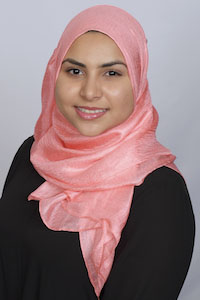 Yasmine Hassan has lived in Arizona her whole life. She was born in Scottsdale and grew up in Chandler.
Yasmine Hassan has lived in Arizona her whole life. She was born in Scottsdale and grew up in Chandler.
When choosing a university, she wanted a convenient commute and a chance to help others and impact lives.
“I knew Arizona State University would provide me the opportunity to thrive and improve in any major,” said Hassan, an information technology major in the Ira A. Fulton Schools of Engineering.
Upon entering the university, Hassan was interested in many diverse fields. Coming from a STEM-related background in high school, she finally stumbled upon the information technology major. Once she enrolled and started attending classes, she felt very passionate about the material and constantly wanted to learn more.
“One aspect I like about technology is that it’s constantly changing. There’s always something new to learn in this dynamic, fast-growing field,” said Hassan. “The advancements in computers and engineering have impacted several fields in our society, including health, education and e-commerce, with the aim of improving our everyday lives.”
Hassan received the New American University Scholar Dean’s Award and the Moeur Award. She has also been on the Dean’s List every semester during her undergraduate education.
“The best piece of advice I’d like to give to those still in school is work hard because it is the key to success,” said Hassan. “Hard work always awards you in the end.”
After graduation, Hassan plans to continue her education in graduate school as part of the accelerated (4+1) bachelor’s and master’s degree program in information technology at ASU.
When asked what problem she would solve with $40 million, Hassan said she’d donate and distribute the money to help children who are orphaned, hungry and abandoned around the world.
WILLIAM JOHNSON
Engineering (Mechanical Systems)
William Johnson sees engineering as perhaps the most powerful change agent in the world. So he’s hoping for career opportunities to change the world for the better in big ways.
Learn more
BSE in Engineering (Mechanical Systems)
Hometown: Phoenix, Arizona
Graduated from Agua Fria High School in Avondale, Arizona
 William Johnson sees engineering as perhaps the most powerful change agent in the world. So he’s hoping for career opportunities to change the world for the better in big ways.
William Johnson sees engineering as perhaps the most powerful change agent in the world. So he’s hoping for career opportunities to change the world for the better in big ways.
“I have a lot of interest in the great engineering achievements we could see in the future,” he says.
One is the Blue Brain Project that aims to accurately map and digitize the human brain. Such an accomplishment might, for instance, help revolutionize the medical field.
By combining brain mapping and digitizing with the ability to provide production-scale nanomachines, it could bring on “a new age where neural damage from some of the most debilitating diseases can be repaired. I could make a life’s work of that,” Johnson says.
Another equally big challenge is optimizing the potential of nanomanufacturing.
“There are many nanoscale technologies that are currently not feasible for use due to the high cost of manufacturing them,” he says. But if the hurdles to a relatively inexpensive, high-volume method of nanomanufacturing can be cleared “it would not take long for major worldwide impacts to be felt.”
Along with dreaming big for his future, Johnson has personal and practical goals.
“I’m getting married soon. I’ve always been very family-oriented. I want to build a life for my family, both current and future members. Upward movement in quality of life for everyone around me, that sort of thing,” he says.
“The where and how is less important than having everyone I love with me. I figure that my next major step toward doing that is starting a successful business, whether in the next year or the next 10.”
Williams says the education he got in the Fulton Schools has prepared him to pursue that goal.
He points, for example, to Associate Professor Pavlos Mikellides, who “teaches in a way that not only challenged me but also challenged the way I see engineering problems in general. He is the only professor I’ve had who has taught me new things simply by the problems he gave us on exams.”
Johnson was supported during his studies by the New American University Scholar award given to outstanding undergraduate students.
He will end his undergrad years by receiving the Mouer Award, given to ASU graduates who have attained exceptionally high academic standing.
NATHAN KISHIYAMA
Aeronautical Management Technology (Air Traffic Management)
Nathan Kishiyama is setting his sights on a career that takes him to a place where the action is. In his field that would be any of the country’s busiest air traffic control towers.
Learn more
BS in Aeronautical Management Technology (Air Traffic Management)
Hometown: Chandler, Arizona
Graduated from Hamilton High School in Chandler, Arizona
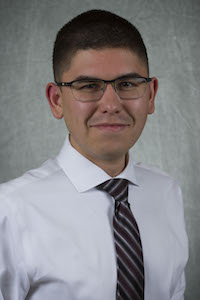 Nathan Kishiyama is setting his sights on a career that takes him to a place where the action is. In his field that would be any of the country’s busiest air traffic control towers.
Nathan Kishiyama is setting his sights on a career that takes him to a place where the action is. In his field that would be any of the country’s busiest air traffic control towers.
One particular experience made him feel like that is the kind of work environment in which he can thrive.
During the year he worked as an intern at the traffic control tower at Phoenix Sky Harbor International Airport. He recalls a time when a complex scenario involving multiple aircraft began to develop over the airport.
“The controller looked to me and said, ‘Well, what would you do with these planes?’ I was able to give a quick answer. To my surprise, the controller did the exact things I said. Turns out, he agreed with my judgment,” Kishiyama says. “To me, it was proof that I was absorbing information about the situation, combining it with our separation requirements, and creating control instructions that would ensure safe and efficient traffic flow.”
Other pursuits he undertook in his undergraduate years reinforced his affinity for the aviation world.
He was a research assistant in Arizona State University’s Aircraft Structures Lab. He was a teaching assistant for STEM classes at the ASU Preparatory Academy and for aviation classes at the East Valley Institute of Technology vocational school.
He did aviation education and community outreach on behalf of ASU and the Federal Aviation Administration. He aided Phoenix Deer Valley Airport in projects to address challenges involving its facilities and with increasing air traffic volume.
Kishiyama credits his success in overcoming the challenges of his college studies to guidance from two “excellent” Fulton Schools faculty members – lecturers John DeLugt and Verne Latham.
He says their dedication and commitment to students motivated him to approach his education with similar determination.
His studies were also supported by earning an ASU Provost’s Scholarship for students demonstrating exceptional academic skills.
Kishiyama’s goals for the future include earning flight instructor certifications, finding opportunities to help implement the use of next-generation air traffic control systems and introducing unmanned aircraft into the National Airspace System.
He also plans to earn a master’s degree, possibly in the Fulton Schools Aviation Management and Human Factors program.
“Regardless of where my career takes me,” Kishiyama says. “I want to make sure I give back [to the aviation community] by volunteering, mentoring and teaching.”
RYAN MAES
Construction Engineering
For Ryan Maes the most rewarding part about his experience at Arizona State University has been being successful with his peers.
Learn more
BSE in Construction Engineering
Hometown: Gilbert, Arizona
Graduated from Highland High School in Gilbert, Arizona
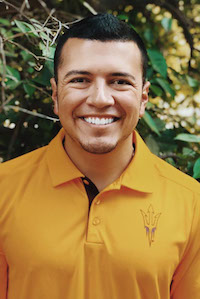
For Ryan Maes, the most rewarding part about his experience at Arizona State University has been being successful with his peers.
“There is not a better feeling than knowing how hard a class is and being able to come out on top and do well with the help and support of your friends around you,” Maes said.
The construction engineering major believed the beginning of a new semester called for a renewed mindset in order to be successful.
“Each semester brings unique challenges and is something that at first I did not realize,” he said. “I began to take each semester one at a time. This helped me set short-term goals that I knew I could accomplish, turning a four-year degree into eight, four-month segments.”
Maes advises those still in school to keep pushing on.
“I remember when I first started, I felt extremely overwhelmed,” he said. “I soon learned everyone is in the same boat and all striving toward the same goal. Lean on the students around you and gain new relationships that will carry you through the rest of your college career. I can tell you that without the support of a few close friends throughout my college experience, I would not be where I am today.”
In addition to those friends, his faith helped guide him through life’s challenges.
“I want to be used by God in any avenue or aspect of the construction industry to be a light for others and be an example of his love,” Maes said. “Whether that is in the construction field or in the office, my dream life would be to be a living example of what it means to follow Christ by serving others and helping them succeed in every walk of life.”
After graduation, he will be working with the company that gave him his first internship in the construction industry, the AECOM Hunt Construction Group.
“They have provided me with a great opportunity to learn and really develop myself as a person,” he said. “I am excited to begin my career with them upon graduation in hopes of one day becoming a leader in this company and growing others in that same path.”
JACK MILLER
Aerospace Engineering
Growing up, Jack Miller had a knack for building match rockets. He spent hours with his best friend, tweaking the designs to see whose rocket would fly the farthest or highest.
Learn more
BSE in Aerospace Engineering
Hometown: Pine Island, Minnesota
Graduated from Pine Island High School
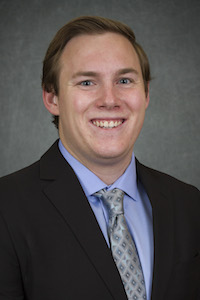 Growing up in Pine Island, Minnesota, Jack Miller had a knack for building match rockets. He spent hours with his best friend, tweaking the designs to see whose rocket would fly the farthest or highest.
Growing up in Pine Island, Minnesota, Jack Miller had a knack for building match rockets. He spent hours with his best friend, tweaking the designs to see whose rocket would fly the farthest or highest.
Miller usually came home with singed clothes, burnt hands and the smell of match smoke, but it solidified his field of study: aerospace engineering.
“Engineering changes the world every single day,” said Miller, an honors student in aerospace engineering at Arizona State University’s Ira A. Fulton Schools of Engineering. “With the advances in aerospace technologies, engineering will not only change this world but all the other worlds we will one day visit.”
Miller received the Srinivasan Iyer Family New American University Scholarship, the Mayo Foundation Scholarship and the Undergraduate Research Apprentice Program Scholarship. With the support of ASU, he also had the opportunity to study abroad in Nepal, South Asia.
As a participant of the Fulton Undergraduate Research Initiative, Miller conducted research on flexible composite propellant tanks under the guidance of Daniel White, a lecturer of aerospace and mechanical engineering. He designed and fabricated a small-scale, flexible composite propellant tank to validate the theoretical advantages of such a device on a larger manufacturing scale.
Miller is also a founding member of Students for the Exploration and Development of Space at ASU Rocketry Division — an organization that designs and builds high-powered rockets for competition. Last year, they won second place in the national University Student Rocketry Competition. They also secured a KEEN grant to fund an experimental sounding rocket for this year’s Spaceport America Cup.
After graduation, Miller will be pursuing a doctoral degree in aerospace engineering with the Adaptive Intelligent Materials and Systems Center. He wants to work with NASA’s Jet Propulsion Laboratory, SpaceX, Blue Origin or start his own company.
IVANA NINKOVIC
Engineering Management
Ivana Ninkovic’s decision to attend Arizona State University was because it was the best fit for her in terms of her academic and athletic goals.
Learn more
BSE in Engineering Management
Hometown: Trebinje, Bosnia and Herzegovina
Graduated from Gimnazija Banja Luka, in Banja Luka, Bosnia and Herzegovina
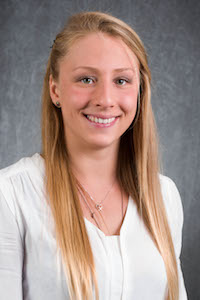
Ivana Ninkovic’s decision to attend Arizona State University was because it was the best fit for her in terms of her academic and athletic goals.
“I chose ASU because it has the perfect blend of quality education, sport, research, climate and recognition,” she says. “All of them together make a huge difference in a student’s career. ASU was the best for me in terms of my academic and athletic goals.”
Ninkovic competed on the women’s swimming and diving team all four years at ASU and served as team captain her senior year. Her outside-the-classroom activities weren’t restricted to the pool though as she participated in the Fulton Undergraduate Research Initiative, where she worked at the Bio-Inspired Robotics Technology and Healthcare Lab.
“My undergraduate research experience has been one of the single most beneficial elements of my education at ASU,” she says. “Not only has research allowed me to learn about a subject I am very interested in on a more in-depth level, it has also taught me valuable critical thinking and problem-solving skills.”
Ninkovic says she has always been interested in engineering.
“I was particularly interested in learning about engineering management because I saw it as an opportunity for me to combine my technical degree with my interest in leadership and desire to work with people.”
Ninkovic competed as a swimmer at the 2012 Olympic Games in London, representing her native Bosnia and Herzegovina before continuing her swimming career at ASU.
“The biggest obstacle for me as student-athlete was the race against the clock,” she says. “Student-athletes are on a tight schedule and constantly on-the-go. You learn how far you can push yourself and make the changes to become better. It was a really rewarding experience.”
She has one last bit of advice to future Fulton Schools students.
“Get involved! It’s always good to start finding your interests early on,” she says. “It helps you to make better decisions later on. Getting involved on campus and within the college has been one of the best decisions I’ve made during my college career.”
MATTHEW OMAN
Electrical Engineering
Matthew Oman chose engineering because it fosters a solution-oriented mindset that he plans to apply during his career in the U.S. Navy. He hopes to help develop aircraft systems and be part of the next phase of space exploration.
Learn more
BSE in Electrical Engineering
Hometown: Chandler, Arizona
Home-schooled
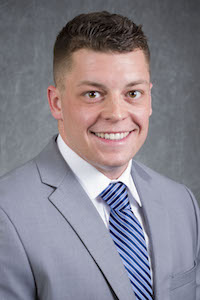 On graduation day, Matthew Oman will be commissioned as an officer in the U.S. Navy and this fall he reports for flight school at the naval air station in Pensacola, Florida. His goal is literally the stars: he hopes to become a test pilot and astronaut.
On graduation day, Matthew Oman will be commissioned as an officer in the U.S. Navy and this fall he reports for flight school at the naval air station in Pensacola, Florida. His goal is literally the stars: he hopes to become a test pilot and astronaut.
It’s a daunting mission, but Oman knows how to persevere. “The one characteristic that has helped me in more ways than any other is tenacity,” he says. “You could be gifted or talented, or your predecessors could have given you all the opportunities in the world, but in the long run, nothing beats a ferocious, undying will to achieve.”
He has always wanted to be a warrior and a pilot, and Navy ROTC offered him the chance to be considered for flight school. Since joining ROTC he has become a respected leader, and for three years, he was the top midshipman in his battalion. He commanded new student orientation for incoming freshmen ROTC students during the summer of 2017 and was the operations officer for ROTC in spring 2017. His senior year he served as battalion commanding officer.
Engineering appealed to him because it teaches a practical kind of intellectual discipline.
“I may not remember all of the equations I have learned over the last few years, but the solution-oriented mindset that engineering fosters is something I will definitely take with me,” he says.
While in the Navy, he plans to earn a master’s degree in aerospace or electrical engineering.
“I hope to use my engineering education to help develop aircraft systems and the Navy’s warfighting ability,” Oman adds, “And I would love to be a part of the next phase of space exploration.”
JORDAN PATTERSON
Mechanical Engineering
A spoon inspired Jordan Patterson to become an engineer. Animals helped her get through her program and a few steps closer to her goal of helping people with engineering.
Learn more
BSE in Mechanical Engineering
Hometown: Scottsdale, Arizona
Graduated from Desert Mountain High School in Scottsdale
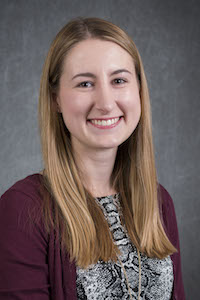
A spoon drew Jordan Patterson to engineering.
Not just any spoon, but the “Parkinson’s spoon” — a utensil designed with stabilizing hardware to keep it steady even if the user’s hand trembles.
“After seeing the impact of one engineer, I knew that’s what I wanted to become — maybe not to change the whole world, but to improve life for one individual at a time,” Patterson says.
Former Fulton Schools Dean Paul Johnson helped show her that ASU was the place for her to meet her goal.
“On my tour of ASU, Dean Johnson walked us through the eSpaces and showed us past projects from freshmen classes and talked about the many opportunities to get involved in hands-on applications like EPICS,” says the New American University Scholarship and National Merit Finalist Scholarship recipient.
Once at ASU, she got right to work on applying what she learned to three projects that help animals and their people through the Engineering Projects in Community Service program.
Patterson helped develop a sustainable way to grow fish and plants with aquaponics system called Aquaponos. The business minor and Barrett, the Honors College student also helped pitch Aquaponos for funding at the eSeed Challenge. As part of the PAWSthetics team, she developed accessible litter boxes for disabled kittens. She also worked on the SweetSense team to create a “scent picture” of the compounds diabetic alert dogs sense.
Patterson also founded Sparky’s Service Dogs, a club that raises awareness for service dogs. As part of the program, Patterson raised a pup named Lani.
“Going into the most stressful semester of engineering (the first semester of junior year), I committed to training this little pup to change someone’s life,” says Patterson. Lani ended up being released from the service dog program, but she’s now an amazing pet who “has a bad habit of opening the fridge.”
After graduation, Patterson will attend grad school to study bio-materials — a field she was inspired to pursue because of her work in materials science Professor Stephen Krause’s lab.
In the long, run she hopes to design medical devices to improve people’s quality of life.
“In the end,” Patterson says, “if I design one device that dramatically improves someone’s life, I will consider myself a successful engineer.”
FREDERICK RIVERS
Chemical Engineering
Frederick Rivers chose to stay close to home for his undergraduate studies, but his future plans will see him marching to Texas for the next chapter of his academic career.
Learn more
BSE in Chemical Engineering
Hometown: Chandler, Arizona
Graduated from Corona del Sol High School in Tempe, Arizona
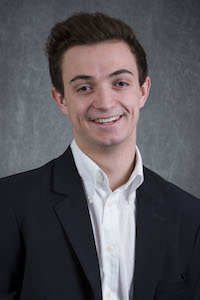
Frederick Rivers was born and raised in Chandler, Arizona. He chose to stay close to home for his undergraduate studies, but his future plans will see him marching to Texas for the next chapter of his academic career.
Rivers, a student in Barrett, The Honors College, will be recognized as Moeur Award recipient for completing his studies at ASU in eight semesters with a 4.0 GPA.
He was a two-time participant in the Fulton Undergraduate Research Initiative, where he used computational methods to model membrane processes for water recovery.
“I learned a lot about computational research while still getting plenty of experience in experimental work,” says Rivers.
Rivers interactions with both faculty and students at ASU left a lasting impression.
“In fall of my junior year, I met a group of other Chem E guys that I can easily call my best friends who I would continually work with and we’ve never had a dull moment together,” Rivers says.
Associate Professor Mary Laura Lind was a mentor to Rivers since he started at ASU.
“Dr. Lind has greatly impacted my growth as an undergraduate,” he says. “She always has given the most helpful advice when making important decisions during my time at ASU, and I am very grateful for her and what she has done for me.”
Outside the classroom, Rivers performed with the independent Winter Guard International performing ensemble Vision Percussion every spring starting in 2016.
“I played marching snare and was section leader the past two seasons,” he says. “In both 2016 and 2017, we received first place in the state in our division.”
As for what’s next, he will be pursuing a doctorate in chemical engineering at the University of Texas at Austin starting fall 2018.
After completion of his doctorate, he hopes to stay in academia and work as a faculty member and professor at a research university.
“That has been a dream of mine ever since I starting being an undergraduate teaching assistant,” he says.
JORDAN M. SEAWRIGHT
Civil Engineering (Structures)
Jordan Seawright aspired to be an architect throughout middle school but discovered early in high school that structural engineering embodied many of the traits he had associated with architecture, plus much more.
Learn more
BSE in Civil Engineering
Hometown: Animas, New Mexico
Homeschooled
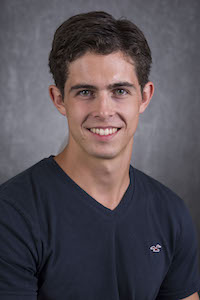 Ever since he was a young boy, Jordan Seawright has been interested in architectural and structural design. He aspired to be an architect throughout middle school but discovered early in high school that structural engineering embodied many of the traits he had associated with architecture and much more.
Ever since he was a young boy, Jordan Seawright has been interested in architectural and structural design. He aspired to be an architect throughout middle school but discovered early in high school that structural engineering embodied many of the traits he had associated with architecture and much more.
“My cousin is a professor and practicing structural engineer, and his engineering stories over the dinner table during family get-togethers are what originally sparked my interest in structural engineering,” said Seawright, who grew up in the small town of Animas, New Mexico. “Approaching graduation, I have no regrets choosing civil-structural engineering as my area of study.”
While studying at Arizona State University’s Ira A. Fulton Schools of Engineering, Seawright received the Mike Kolling Memorial Scholarship from Achen-Gardner Construction, the Civil and Environmental Engineering General Scholarship, and the ASU President’s Award.
Seawright was an undergraduate teaching assistant for three courses in civil and environmental engineering during his junior and senior years — dynamics, deformable solids and steel structures.
“Working as a UGTA was one of the most valuable experiences from my time at ASU,” said Seawright. “I acquired teaching and public speaking skills, while giving back to the community by sharing my knowledge of those courses. If I weren’t graduating this semester, I would certainly return for another year of the program.”
Currently, Seawright is participating in the 4+1 accelerated master’s program, and he has taken four graduate courses during his senior year. He will complete his master’s degree in the upcoming year. Afterwards, he plans to pursue a PhD in structural engineering.
“In the long-term, I want to be a consulting structural engineer who does both design and forensic work,” said Seawright. “My dream is to do structural design for spacecraft, and this is becoming more feasible with the privatization of the space industry.”
Seawright is also a professional Latin ballroom dancer, and he has been a part of the sport since he was seven years old. After graduation, he and his partner are traveling to Blackpool, England, to compete at the Blackpool Dance Festival, one of the most prestigious competitions in the world.
“It has certainly been a challenge to train for competitions while being a full-time student and turning in quality work, but it was worth the effort. I wouldn’t trade the experience for anything,” said Seawright.
KYLIE SOUTHARD
Environmental and Resource Management
Kylie Southard says she came to ASU to explore the possibilities of many different fields, and to collaborate with people with different backgrounds, ideas and passions.
Learn more
BS in Environmental and Resource Management, minor in Sustainability
Hometown: Eau Claire, Wisconsin
Graduated from Memorial High School in Eau Claire, Wisconsin
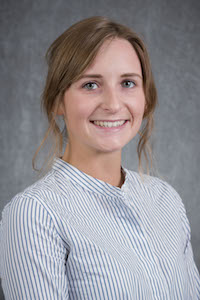 Kylie Southard says she came to ASU to explore the possibilities of many different fields, and to collaborate with people with different backgrounds, ideas and passions.
Kylie Southard says she came to ASU to explore the possibilities of many different fields, and to collaborate with people with different backgrounds, ideas and passions.
She began her ASU career in the field of earth studies, but it didn’t hold her attention — “the fervency wasn’t there,” Southard says.
Then the Environmental and Resource Management program at the Polytechnic campus caught Southard’s interest.
“I wanted something more math and science intensive that also had a clear focus in environmental science and sustainable concepts,” says Southard, who also is completing a minor in sustainability.
Southard earned a Walton Scholarship from the ASU Global Sustainability Studies Program in 2017, a scholarship given to students who exemplify the kind of leadership needed to create a more sustainable world. As part of the scholarship program, Southard studied water resources and wildlife economy in South Africa. The experience built on Southard’s previous global work as a volunteer at a Thailand elephant sanctuary in summer 2016.
Besides studying environmental and resource management and sustainability, Southard served on the ASU Club Tennis Team officers board as the event coordinator and sang in the ASU Women’s Choir. She also loves to play the ukulele and piano, practice yoga and run — two years ago she ran her first half marathon.
After graduation, Southard plans to study field archeology and geophysical testing over the summer at the Center for American Archeology at ASU’s Kampsville Field School in Kampsville, Illinois. Then she’ll start an internship at Honeywell’s Aerospace Headquarters in Phoenix that continues through the fall. Southard also will begin the Environmental and Resource Management master’s program at ASU in the fall with support from the Phoenix Panhellenic Scholarship.
Southard sees her future as a hopeful place where she can positively influence the environment and people around her.
“I would like to engage in research globally and become a better public speaker,” she says. “I hope that I will be able to collaborate and be inspired by many remarkable people while also influencing other people with my own work.”
RYAN WINDISH
Construction Management
By day, Ryan Windish is an aspiring entrepreneur of construction subcontracting. By night, he’s a former powerlifting competitor who applies a positive attitude and solid technique to his academic endeavors.
Learn more
BS in Construction Management
Hometown: Tucson, Arizona
Graduated from Ironwood Ridge High School in Oro Valley, Arizona
 By day, Ryan Windish is an aspiring entrepreneur of construction subcontracting. By night, he’s a former powerlifting competitor who applies a positive attitude and solid technique to his academic endeavors.
By day, Ryan Windish is an aspiring entrepreneur of construction subcontracting. By night, he’s a former powerlifting competitor who applies a positive attitude and solid technique to his academic endeavors.
Windish was born in Indianapolis, Indiana, and grew up in Tucson, Arizona. He followed his father’s footsteps, which led him to Arizona State University’s Ira A. Fulton Schools of Engineering.
“My dad graduated with a bachelor’s degree in aerospace engineering and this was a big reason why I chose ASU,” said Windish, a construction management major in the Del E. Webb School of Construction.
While attending ASU, Windish received the Provost’s Scholarship. The award is part of the New American University Scholar program, which supports students as they pursue academic excellence.
Time management was important to Windish as he completed internships with construction companies, maintained high grades in construction management coursework and trained for powerlifting competitions.
Currently, Windish is a project engineer intern at Layton Construction. He works in the tenant improvement division, which allows him to work on several smaller and faster-paced projects. Upon graduation, he wants to continue working at Layton. Previously, he interned with Okland Construction and had the opportunity to participate on the construction of Tooker House.
Windish also competed in a powerlifting competition more than a year ago. He won in the junior/open divisions for his weight class and received an award for best lifter of the meet. While he no longer competes, powerlifting remains a big part of his workout regimen as well as in other aspects of his life.
Windish’s training in powerlifting has taught him the importance of having a strong mindset and putting forth the effort to accomplish his goals.
“At the end of the day, I had to sacrifice in order to stay on top of things,” he said.
JIAQI WU
Computer Science
Jiaqi Wu’s took full advantage of opportunities to dig deep into her studies and research interests by earning multiple scholarships during her time at ASU.
Learn more
BS in Computer Science
Minor in Biological Sciences
Hometown: Peoria, Arizona
Graduated from Centennial High School in Peoria, Arizona
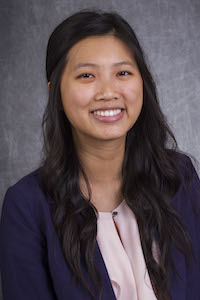 Even as a youngster, Jiaqi Wu’s favorite subjects in school were those related to science, engineering, technology and math. In high school her interests began to take on a sharper focus.
Even as a youngster, Jiaqi Wu’s favorite subjects in school were those related to science, engineering, technology and math. In high school her interests began to take on a sharper focus.
“I found myself enjoying the logic behind programming a computer,” she recalls. At the same time, in a biology class, she “saw the parallels between programming a living cell and programming a computer.”
That revelation set the path for her pursuits in college as a student in Arizona State University’s Barrett, the Honors College and Ira A. Fulton Schools of Engineering.
She took full advantage of opportunities to dig deep into studies and research on her interests — opportunities that she opened for herself by earning multiple scholarships.
In addition to Arizona State University’s New American University Scholars Program Presidents Award, she won scholarships though the Fulton Schools, including a Panhuise Engineering Scholarship, a Boeing Scholarship, the Jodie Filardo Scholarship, and the Women in STEM Scholarship.
She also earned two fellowships through the Barrett Bidstrup Foundation Undergraduate Fellows Program for her work on research projects guided by two Fulton Schools faculty members
For her honors thesis, Wu worked with Assistant Professor Sharon Hsiao on a computer science project to develop an educational analytics application called Study Genie, an intelligent and collaborative web-based study platform.
Assistant Professor Karmella Haynes guided Wu on bioinformatics research exploring the potential for an engineered anti-cancer protein to also be used to treat diabetes.
But the biggest research thrill was teaming with fellow students for the International Genetically Engineered Machine competition, known as iGEM, the leading synthetic biology contest for college students.
That ASU team won an iGEM gold medal by taking first-place awards in two major categories of the competition and earning nominations for the top awards in two other categories.
Wu’s work through the Fulton Undergraduate Research Initiative brought her grants to fund trips to three major international science and engineering conferences, while her academic performance got her on the Fulton Schools Dean’s List every semester.
Her interests in both computer science and biology have melded into an ambitious career aspiration.
“My research interests seemed scattered at first,” Wu says. “But looking back, I can see the dots connecting and everything coming together.”
She now intends to expand her expertise by pursuing a master’s degree in computer science with a concentration in computational biology.
It’s the next step in Wu’s plans for a career helping to solve some of the world’s biggest biology challenges.
IMPACT Award Recipients
SCOTT BOEGE
Biomedical Engineering
Scott Boege first decided to study biomedical engineering because of the need to improve prosthetics for amputees.
Learn more
BSE in Biomedical Engineering
Hometown: Chandler, Arizona
Graduated from Corona del Sol High School in Tempe, Arizona
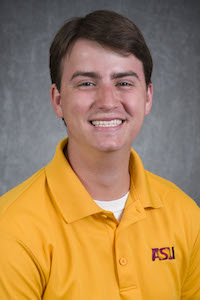 Learning about his brother’s experiences serving in Iraq inspired Scott Boege to major in biomedical engineering.
Learning about his brother’s experiences serving in Iraq inspired Scott Boege to major in biomedical engineering.
“I became more aware of the issues facing soldiers returning home, one of them being amputations,” he explains. “I realized that the technology could be improved, and I wanted to make a difference. I chose biomedical engineering because it was a way for me to get involved in this research field.”
At the Ira A. Fulton Schools of Engineering, Boege had plenty of opportunities to work on prosthetics research, especially projects involving hands. One of his most rewarding experiences was working in Professor Marco Santello’s lab, helping to optimize a robotic hand.
“About a year later, I learned about a competition where amputees used different types of prosthetics to complete various tasks,” he explains. “A man with the same model prosthetic hand that I worked on performed the best. Seeing that made me believe that I can have a positive impact on any project I work on.”
During an internship at the startup company Neolight, he led the temperature testing for a medical device to assure that it could be used in an incubator. His contribution helped the company obtain Federal Drug Administration clearance.
Boege also was deeply involved in the Biomedical Engineering Society and was vice president when the chapter was ranked No. 2 in the nation and was awarded the Commendable Achievement Award. He also interned at the non-profit Project C.U.R.E., which sends used medical devices and equipment to countries in need.
His parting advice for those following him at the Fulton Schools is to get an internship, especially at a startup. “I had three internships, and they all helped connect what I was learning in school with the application of that knowledge,” he says.
BERENICE CASTRO
Industrial Engineering
Berenice Castro recalls the book “The Last Lecture” providing the spark that ignited her interest in engineering.
Learn more
BSE in Industrial Engineering
Hometown: Nogales, Arizona
Graduated from Nogales High School
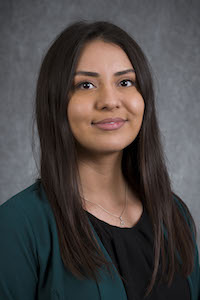 Berenice Castro recalls the book “The Last Lecture” providing the spark that ignited her interest in engineering.
Berenice Castro recalls the book “The Last Lecture” providing the spark that ignited her interest in engineering.
Written by engineer and Carnegie Mellon University Professor Randy Pausch, the book chronicles the well-known public lecture he gave after he was diagnosed with a terminal form of cancer.
Pausch designed the lecture to provide his children with the life lessons he wanted them to learn and remember after he was gone — lessons about achieving one’s dreams and helping others to attain their dreams.
Reading the book while in high school, Castro was captivated by Pausch’s perspective on how to fulfill such dreams. That’s when she began thinking of engineering as a dream career, “because engineers turn imagination into reality,” she says.
She has also been inspired by Hedy Lamarr, one of the most famous movie stars of the 1930s and ‘40s, who invented a remote-controlled communications system used during World War II and developed a frequency-hopping theory that had an influence on the creation of some of today’s technologies such as Wi-Fi and Bluetooth.
Lamarr’s example proves women “can be both feminine and artistic, as well as technically skilled and innovative,” Castro says.
Driven by Pausch’s motivating messages and Lamarr’s accomplishments, Castro has had an impressive undergraduate career as an engineering major and a student in ASU’s Barrett, the Honors College.
In addition to an exemplary academic performance, she has been president of student organization Latinos in Science and Engineering and a member of the Arizona State University chapter of the Institute of Industrial and Systems Engineers.
She took on roles in industrial engineering, supply chain engineering and commodity management in internships with Intel Corporation, and in production control during an internship at Orbital ATK.
She gained further work experience through student-industry project collaborations with the prominent technology companies Avnet and W.L. Gore & Associates.
Castro was equally as active in community service and outreach projects.
She was a STEM Program mentor for Si Se Puede Foundation projects that introduced youngsters to science and engineering through robotics activities, as well as in programs designed to encourage interest in science and engineering among middle school and high school students.
She has also been an Engineering Futures Mentor for the Ira A. Fulton Schools of Engineering, mentoring first-generation college students who are pursuing studies and careers in engineering.
Her list of undergraduate awards includes a John and Helen Butler Scholarship and scholarships from Latinos in Science and Engineering, the Hispanic Scholarship Foundation and ASU’s New American University Provost Scholarship program.
There were also leadership awards from the Si Se Puede Foundation and the U.S. Marine Corps for her contributions as a president and mentor for Latinos in Science and Engineering.
“I love seeing some of the students who I worked with when they were in high school, and inspiring them to study engineering and then seeing them as engineering freshmen at ASU,” Castro says. “It shows me that what I’ve been doing is making a difference.”
Through the Fulton Schools 4+1 program, Castro will continue studies after graduation to earn a master’s degree in industrial engineering. She has also taken a graduate student intern position with Intel.
Beyond the next degree, she is hoping for career opportunities to help solve some of what she sees as the world’s biggest challenges.
“I would love to work on creating more sustainable energy sources,” Castro says. “Human-caused problems are getting irreversible and it’s going to be catastrophic if we don’t slow things down and reduce our carbon footprint. It’s imperative that we do something to change that situation.”
Outside of career pursuits, Castro spends time on artistic hobbies and activities, specifically salsa dancing, singing and drawing with charcoal and oil pastels.
“Engineers need creative outlets,” she says, “I think it helps make us better engineers.
ERIN HUBER
Mechanical Engineering
Erin Huber did not really understand what it meant to “be an engineer” when she was in high school.
Learn more
BSE in Mechanical Engineering
Hometown: Des Moines, Iowa
Graduated from Valley Vista High School in Surprise, Arizona
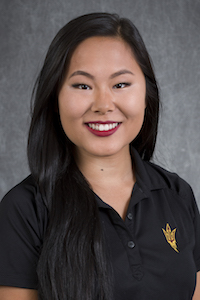 Erin Huber did not really understand what it meant to “be an engineer” when she was in high school.
Erin Huber did not really understand what it meant to “be an engineer” when she was in high school.
“The first time I heard about engineering was at a STEM awards dinner that was hosted at the Polytechnic campus,” Huber says. “I was at the awards dinner for math, but they had current engineering students talking about how their projects are impacting communities globally and really making a difference.”
Huber actually thought for the longest time that she was going to go to the University of Arizona.
“I visited Tucson for an overnight stay, and I didn’t like the feel of the campus or Tucson,” she says. “Both colleges have great engineering programs, but ASU felt like it would have more opportunities for involvement, jobs and mentors. I knew I wanted to stay in state, so ASU was a natural choice.”
Huber, a Barrett, The Honors College student, wanted to have a full, enriched experience in college.
“I have never been one to just stick to the basics and do enough to ‘get by’,” she says. “I got really involved in the engineering college through my peer mentor position sophomore year. I like to stay busy and challenge myself to handle it all!”
Huber definitely did not just “get by” while in the Fulton Schools. She was in the Society of Women Engineers for three years, EPICS for two semesters, Formula SAE for one semester, community service organization Omega Phi Alpha for two and a half years and Barrett choir for two semesters.
“I was vice president, internal relations chair and student engagement chair for SWE,” she says. “I was a teaching assistant for ASU 101 sophomore year. I have been an academic peer mentor for three years, and I am currently the Sr. peer mentor.”
After graduation Huber will be re-locating to Washington to work for the Boeing Company, but hopes to return to school in the future.
“I want to get involved with female STEM outreach in the industry because there is still a huge lack of diversity in the engineering world. I think a huge achievement would be to help more young girls get interested in engineering to lessen that gender gap.”
Huber’s advice to current and future Sun Devils is to get involved outside the classroom.
“Grades are important, but they are not everything,” she says. “It is silly that so many students just do the bare minimum in college! Students need to be able to stand out, not only for employers and getting employed but also for personal growth. Join clubs and organizations, take on leadership positions, get involved in research, study abroad … do something that interests you and pushes yourself out of your comfort zone!”
DESTRY JACOBS
Aeronautical Management Technology (Air Transportation Management)
Since Destry Jacobs was a kid she always enjoyed being part of something bigger than herself.
Learn more
BS in Aeronautical Management Technology (Air Transportation Management)
Hometown: Apple Valley, California
Graduated from Sultana High School in Hesperia, California

Since Destry Jacobs was a kid, she always enjoyed being part of something bigger than herself.
“Being a member of clubs and other organizations have been a way for me to do what I am passionate about and grow outside of the classroom,” she says. “They are great supplements to academia.”
The air transportation management major supplemented her time in the classroom in many ways. Jacobs was a member of ASU’s Women in Aviation International chapter where she served as both secretary and vice president. She was a four-year member of Fulton Ambassadors at ASU’s Polytechnic campus and served as president for the past two. She also worked in the Fulton Schools Dean’s Office on the Polytechnic campus as a recruitment assistant. She was also the president of Colleges Against Cancer.
Jacobs credits Mary Niemczyk, associate professor of aviation, with playing an influential part in her journey at ASU.
“I cannot explain how much her support and interest in my education and subsequent career has helped me,” says Jacobs. “She has moved boulders to help me attend conferences, apply for scholarships and has provided priceless advice. Dr. Niemczyk has been a pillar in my education! I will always be grateful for her guidance, especially as I dive into my master’s degree as part of the 4+1 program.”
When she was a freshman, Jacobs met a fellow student who was returning to school to get her degree. That student helped her define what it means to be successful.
“One evening she told me about her life,” says Jacobs. “She recounted a point in her life when she had a huge house, a spouse, beautiful kids, a job that she traveled with and a paycheck in the six figures. She must had seen the confused look on my face as I wondered why she would give it all up to go back and reinvent her life.”
Jacobs says that was when she told her one of the most important pieces of advice she has ever received — “You must define your own version of success.”
“We get so caught up in the idea of success laid out for us and what success should mean,” she says. “The question we should be asking is what is it that you want out of life? What does success mean to you? You have the power to define that and shape your life. Don’t forget that.”
MONICA KIILEHUA
Industrial Engineering
Monica Kiilehua has been heavily involved as a student in the Fulton Schools and as a member of her community in the Phoenix metropolitan area.
Learn more
BSE in Industrial Engineering
Hometown: Tucson, Arizona
Graduated from University High School in Tucson, Arizona
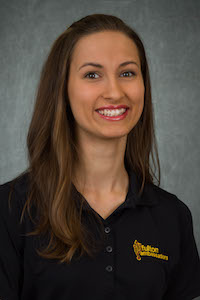 Offering a nationally ranked program, sunny climate and student engagement opportunities, Arizona State University was the best match for Monica Kiilehua, an industrial engineering major in the Ira A. Fulton Schools of Engineering. Tempe was also the perfect distance from her home in Tucson, Arizona — just far enough to be independent but not too far from her family and friends, she said.
Offering a nationally ranked program, sunny climate and student engagement opportunities, Arizona State University was the best match for Monica Kiilehua, an industrial engineering major in the Ira A. Fulton Schools of Engineering. Tempe was also the perfect distance from her home in Tucson, Arizona — just far enough to be independent but not too far from her family and friends, she said.
“At first, I was hesitant to pursue engineering. It sounded intimidating … I felt like I might not fit in,” said Kiilehua, who received a National Merit Corporation Scholarship, ASU’s National Scholar Award and a Chick-fil-A Leadership Scholarship. “I gave industrial engineering a shot, and it’s been a great fit.”
Kiilehua has been heavily involved as a student in the Fulton Schools and as a member of her community in the Phoenix metropolitan area. She said she was eager to grow as an individual, contribute her talents as a leader and secure internships for professional development.
She was a member of nine student organizations. Most notably, she’s the current president of the Institute of Industrial and Systems Engineers, a Fulton Ambassador and a mentor for the School of Computing, Informatics and Decision Systems Engineering — one of the six Fulton Schools.
Kiilehua also participated in Engineering Projects in Community Service and volunteered at a few nonprofits around the valley, including Project C.U.R.E., Feed My Starving Children, Sunshine Acres Children’s Home and FOCUS North America.
“I enjoy giving my time to help others,” she said. “If I have the time, energy and capability to be of service, then why not?”
Starting this fall, Kiilehua will be a full-time graduate student pursuing a master’s degree in industrial engineering as part of ASU’s accelerated 4+1 program. She also has a summer internship lined up with W. L. Gore & Associates, Inc., a global technology-driven company focused on product innovation.
ETHAN MARSCHALL
Biomedical Engineering
Ethan Marschall chose ASU because as a top tier research university it offered the research opportunities he sought in biochemistry, biology, neuroscience and other fundamental sciences.
Learn more
BSE in Biomedical Engineering
Hometown: Queen Creek, Arizona
Graduated from Highland High School in Gilbert, Arizona
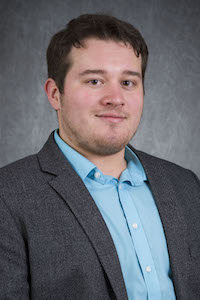 Ethan Marschall chose Arizona State University because as a top tier research university it offered the research opportunities he sought in biochemistry, biology, neuroscience and other fundamental sciences. Those are challenging fields, he says, but engineering intimidated him “a bit.”
Ethan Marschall chose Arizona State University because as a top tier research university it offered the research opportunities he sought in biochemistry, biology, neuroscience and other fundamental sciences. Those are challenging fields, he says, but engineering intimidated him “a bit.”
He should not have worried. At the Fulton Schools, Marschall has used engineering in biomedical research projects through the Fulton Undergraduate Research Initiative program, the Fulton Grand Challenge Scholars Program and his honors thesis. And he helped solve problems for two nonprofits through the Engineering Projects in Community Service program.
Marschall’s advice to other students is to get involved. He’s graduating with about 100 credit hours more than required, but he still found time for student activities. He was president of the Biomedical Engineering Society senior year and showed off the Fulton Schools to visitors and prospective students as a Fulton Ambassador. He also worked with Project C.U.R.E., a non-profit that ships unused medical supplies from hospitals in the U.S. to locations across the world where they are needed.
At E2, the Fulton Schools’ summer camp for incoming students, Marschall started as a camp counselor and eventually moved up to become one of the Student Leads.
“I took on a much more hands-on role preparing for the camps, and it really pushed my limits to grow as a person,” he explains. “I’m not naturally extroverted, but I really enjoyed my time interacting with so many people both before E2 and at the camp itself.”
Marschall will continue at the Fulton Schools for one more year, completing the 4+1 accelerated degree program in biomedical engineering.
“There’s an immense amount of creative problem solving and small team work in engineering,” he says. “As a biomedical engineer, I hope to bring about some unique medical advancement and change patient lives for the better.
SAMI MIAN
Computer Engineering
Sami Mian applies himself in all facets of engineering, from his master’s thesis research to entrepreneurial endeavors to STEM outreach.
Learn more
BSE in Computer Systems Engineering
BS in Computational Mathematical Sciences
MS in Computer Engineering with a concentration in Computer Systems Engineering
Hometown: Scottsdale, Arizona
Graduated from Chaparral High School in Scottsdale, Arizona
Sami Mian applies himself in all facets of engineering, from his master’s thesis research to entrepreneurial endeavors to STEM outreach.
After completing two bachelor’s degrees at ASU, Mian decided to stay at ASU to work on his master’s. Working under advisors Spring Berman, assistant professor of mechanical engineering, and Sethuraman Panchanathan, executive vice president of the ASU Office of Knowledge Enterprise Development and senior sustainability scientist, Mian conducted his thesis research on enabling fleets of unmanned aerial vehicle swarms to operate in a smart city environment with optimized power requirements.
Mian says Panchanathan’s guidance was particularly instrumental in his success as a researcher and engineer.
“The amount of independence he allowed me to have and his trust that I’d be able to work with that kind of independence was fantastic,” Mian says. “He let me focus on my own ideas and vision, with guidance and support when needed, and it ended up being quite successful.”
Mian’s UAV work has allowed him to contribute to the Federal Aviation Administration and Arizona government efforts to develop Arizona drone policy.
Beyond UAVs, Mian applied his engineering expertise as Hoolest Performance Technologies’ CTO and co-founder. Mian built a prototype of the anxiety-relieving earbuds and helped take the company from an idea to a successful startup. Earlier this spring, Hoolest won the $100,000 first-place prize at the ASU Innovation Open.
His high achievements as an ASU entrepreneur earned him the designation of Prescott Fellow given to top innovators from ASU’s Entrepreneurship + Innovation eSeed Challenge.
Mian has also used his varied engineering experiences to help others be successful. At ASU, he mentored teams in the Engineering Projects for Community Service program, ASU hackathon teams and worked in KED’s Luminosity Lab as an engineering lead, where he mentored 20 graduate and undergraduate engineers. Beyond college students, Mian mentored students of all ages as part of FIRST programs.
“Getting kids interested [in STEM] and allowing them to learn at a young age helps them be successful and helps society as a whole,” Mian says.
He has even taken his outreach efforts internationally. As part of the BUILD-IT program, Mian used his undergraduate capstone project to improve hands-on engineering curriculum at Vietnamese universities.
No matter where Mian ends up for his doctorate, he’ll continue to research, innovate and foster a passion for engineering in students of all ages.
“It doesn’t matter where I go next, I’m going to keep giving back and creating a better community,” Mian says. “People around the world have realized the importance of engineering and innovation.”
AMANDA NGUYEN
Biomedical Engineering
Amanda Nguyen wanted to stay in-state for college. Her passion of science and engineering combined with a desire to help people drove her to study engineering at ASU.
Learn more
BSE in Biomedical Engineering
Hometown: Ahwatukee, Arizona
Graduated from Mountain Pointe High School in Phoenix, Arizona
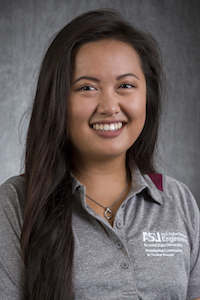 Originally from Ahwatukee, Arizona, Amanda Nguyen wanted to stay in-state for college. Her passion of science and engineering combined with a desire to help people drove her to study engineering at Arizona State University.
Originally from Ahwatukee, Arizona, Amanda Nguyen wanted to stay in-state for college. Her passion of science and engineering combined with a desire to help people drove her to study engineering at Arizona State University.
“I fell in love with engineering,” said Nguyen, a biomedical engineering major in the Ira A. Fulton Schools of Engineering and Barrett, The Honors College. “Engineers solve problems in the world that other people can’t. We innovate and create new products that will change the future.”
Nguyen participated in nearly every program offered by the Fulton Schools. After joining the community, she was passionate about sharing her experiences as an engineering major with prospective and fellow students.
She served as a camp counselor at E2, a tutor at the engineering tutor center and a residential peer mentor at Palo Verde East and Tooker House. She also gave tours as a Fulton Ambassador, guided students as an undergraduate teaching assistant, interned every summer and conducted research through the Fulton Undergraduate Research Initiative.
As part of the FURI program, Nguyen worked with an ear, nose and throat surgeon at the Mayo Clinic to develop patient-specific vocal fold implants. She was able to present her research at the 2016 Biomedical Engineering Society Conference in Minneapolis, Minnesota. Nguyen also has a provisional patent on a surgical patient warming system.
Nguyen had six different job offers leading up to graduation. She’s decided to move to the Seattle, Washington, area to become a customer quality engineer at Stryker Physio-Control, a company focused on the design, development and manufacturing of external defibrillator/monitors and emergency medical response products and services.
“I want to be able to say that what I’m working on creating or developing has a real impact on others through the medical device and technology field,” said Nguyen.
SAMUEL PEREZ
Electrical Engineering
Community has been a driving force in Samuel Perez’s time at ASU, and he worked hard to foster a sense of community wherever he got involved.
Learn more
BSE in Electrical Engineering
Hometown: Culiacan, Sinaloa, Mexico
Graduated from Sierra Linda High School in Phoenix, Arizona
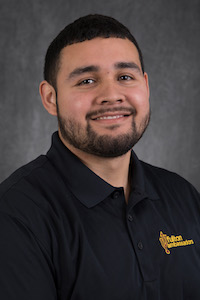 Community has been a driving force in Samuel Perez’s time at ASU, and he worked hard to foster a sense of community wherever he got involved.
Community has been a driving force in Samuel Perez’s time at ASU, and he worked hard to foster a sense of community wherever he got involved.
He encouraged his community at the Society of Hispanic Professional Engineers as its president and treasurer. His biggest achievement in those roles was the organization’s Spike It For Charity volleyball tournament that raised $1,000 for disaster relief in Puerto Rico and Mexico. He also was a lead in the first-ever Hispanic Heritage Month Fall Service Plunge — an event to help the Sun Devil community meet other service-minded individuals.
A first-generation college student, Perez has enjoyed sharing his story with the ASU and wider communities.
“My story summarizes a difficult transition from high school to the university, where I struggled to make new friends in new environment with challenging academics. Now I have a 3.41 GPA, two internships under my belt, have been president of the SHPE and a mentor for the Be A Leader Foundation and have a full-time job offer from Microsoft,” says Perez, who also earned many scholarships, including the Gary and Diane Tooker Scholarship for Engineering.
Perez has also enjoyed the community of faculty he has worked with in the Fulton Schools, especially Assistant Dean of Engineering Education and Associate Research Professor Tirupalavanam Ganesh, Professor Armando Rodriguez and Professor Chaitali Chakrabarti.
“Dr. Ganesh’s passion for education inspired me to get more involved in outreach and give back to my community. Dr. Rodriguez’s character and love for engineering helped me see that my community can achieve amazing things. Dr. Chakrabarti’s selflessness and student advocacy allowed me to see the impact that can be made in someone’s life … and set an example for the person I would love to become in the future,” Perez says.
After graduating with a bachelor’s in electrical engineering and a minor in business, Perez will move to Seattle, Washington, to start a job with Microsoft. After a few years of working there he wants to return to school to get an MBA.
“My short-term goal is to be a key player at the company I work at, and I’ve always dreamed about being a team leader,” says Perez, who enjoyed being a team leader as part of his Engineering Projects in Community Service team at ASU. “After many years, I dream of starting my own scholarship foundation to help students like me.”
CODY VAN CLEVE
Engineering (Systems Engineering)
Cody Van Cleve has boldly set the bar high for his aspirations for the future.
Learn more
MSE in Engineering (Systems Engineering)
Hometown: Tucson, Arizona
Graduated from Ironwood Ridge High School in Oro Valley, Arizona
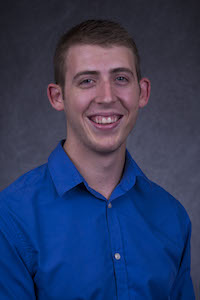 Cody Van Cleve has boldly set the bar high for his aspirations for the future.
Cody Van Cleve has boldly set the bar high for his aspirations for the future.
“My dream is to start and run a company that makes a huge, positive difference in the world,” he says.
Numerous, varied and impressive accomplishments as an undergraduate and graduate student offer no reason to think such a goal is beyond his capabilities.
As a student in Arizona State University’s Barrett, the Honors College, he earned the highest possible grade point average each semester of his undergraduate studies for a bachelor of science degree in engineering with concentrations in robotics and electrical systems engineering. He was selected as the spring 2017 Outstanding Graduate in his degree program.
Van Cleve maintained that high level of performance in coursework while at the same time being almost continually involved in research projects, teaching assistant assignments, education outreach on behalf of the Fulton Schools and ASU, and working internships and part-time jobs.Participating in the Fulton Undergraduate Research Initiative, he worked on making advancements in intelligent safety gear technology for motorcyclists.
For his senior year engineering design capstone project, he managed a team of six students that built a robotic manipulator arm as part of an industrial manufacturing automation system.
For his graduate research project, he joined ASU’s Laboratory for Energy and Power Solutions to develop technology to modernize the electrical grid and make it adaptable to future technological advances.
During two summer internships with Raytheon, a major defense industry company, he took on manufacturing and automation engineering roles in missile systems development projects. Van Cleve later worked part-time to support Raytheon’s educational initiatives at ASU.
Among many outreach efforts, he aided ASU recruiting of high school students and was a live-in camp counselor at the ASU Summer Transportation Institute — a transportation engineering introduction program for high school students.
He worked as a tool instructor at ASU’s largest on-campus manufacturing facility and helped to market the lab facilities and boost enrollment in the manufacturing engineering program, plus did similar outreach for a campus industrial robotics lab.
In his graduate studies he again attained the highest possible grade point average.
Van Cleve performed not only in the classroom, in the lab and on the job, but on the concert stage. He joined ASU’s Barrett Choir to sing in France on the 70th anniversary of the World War II D-Day invasion, and in a classical choral-orchestral performance in Paris.
His array of talents earned him support for his studies, including ASU’s New American University Scholarship, the Mouer Award for academic performance and the Factors Southwest Funding Entrepreneurial Scholarship.
In addition, he has been offered a Fulton Schools Dean’s Fellowship award that will enable him to pursue a doctoral degree within the next four years.
Asked to choose the most memorable moment of his college experience, Van Cleve emphatically says it was, of course, the first time he saw fellow Fulton Schools engineering student Carly Thalman, who recently became his wife.
Fulton Schools Convocation Speakers
Maroon Ceremony Speaker
BERENICE CASTRO
Industrial Engineering
Berenice Castro recalls the book “The Last Lecture” providing the spark that ignited her interest in engineering.
Learn more
BSE in Industrial Engineering
Hometown: Nogales, Arizona
Graduated from Nogales High School
 Berenice Castro recalls the book “The Last Lecture” providing the spark that ignited her interest in engineering.
Berenice Castro recalls the book “The Last Lecture” providing the spark that ignited her interest in engineering.
Written by engineer and Carnegie Mellon University Professor Randy Pausch, the book chronicles the well-known public lecture he gave after he was diagnosed with a terminal form of cancer.
Pausch designed the lecture to provide his children with the life lessons he wanted them to learn and remember after he was gone — lessons about achieving one’s dreams and helping others to attain their dreams.
Reading the book while in high school, Castro was captivated by Pausch’s perspective on how to fulfill such dreams. That’s when she began thinking of engineering as a dream career, “because engineers turn imagination into reality,” she says.
She has also been inspired by Hedy Lamarr, one of the most famous movie stars of the 1930s and ‘40s, who invented a remote-controlled communications system used during World War II and developed a frequency-hopping theory that had an influence on the creation of some of today’s technologies such as Wi-Fi and Bluetooth.
Lamarr’s example proves women “can be both feminine and artistic, as well as technically skilled and innovative,” Castro says.
Driven by Pausch’s motivating messages and Lamarr’s accomplishments, Castro has had an impressive undergraduate career as an engineering major and a student in ASU’s Barrett, the Honors College.
In addition to an exemplary academic performance, she has been president of student organization Latinos in Science and Engineering and a member of the Arizona State University chapter of the Institute of Industrial and Systems Engineers.
She took on roles in industrial engineering, supply chain engineering and commodity management in internships with Intel Corporation, and in production control during an internship at Orbital ATK.
She gained further work experience through student-industry project collaborations with the prominent technology companies Avnet and W.L. Gore & Associates.
Castro was equally as active in community service and outreach projects.
She was a STEM Program mentor for Si Se Puede Foundation projects that introduced youngsters to science and engineering through robotics activities, as well as in programs designed to encourage interest in science and engineering among middle school and high school students.
She has also been an Engineering Futures Mentor for the Ira A. Fulton Schools of Engineering, mentoring first-generation college students who are pursuing studies and careers in engineering.
Her list of undergraduate awards includes a John and Helen Butler Scholarship and scholarships from Latinos in Science and Engineering, the Hispanic Scholarship Foundation and ASU’s New American University Provost Scholarship program.
There were also leadership awards from the Si Se Puede Foundation and the U.S. Marine Corps for her contributions as a president and mentor for Latinos in Science and Engineering.
“I love seeing some of the students who I worked with when they were in high school, and inspiring them to study engineering and then seeing them as engineering freshmen at ASU,” Castro says. “It shows me that what I’ve been doing is making a difference.”
Through the Fulton Schools 4+1 program, Castro will continue studies after graduation to earn a master’s degree in industrial engineering. She has also taken a graduate student intern position with Intel.
Beyond the next degree, she is hoping for career opportunities to help solve some of what she sees as the world’s biggest challenges.
“I would love to work on creating more sustainable energy sources,” Castro says. “Human-caused problems are getting irreversible and it’s going to be catastrophic if we don’t slow things down and reduce our carbon footprint. It’s imperative that we do something to change that situation.”
Outside of career pursuits, Castro spends time on artistic hobbies and activities, specifically salsa dancing, singing and drawing with charcoal and oil pastels.
“Engineers need creative outlets,” she says, “I think it helps make us better engineers.
Gold Ceremony Speaker
ERIN HUBER
Mechanical Engineering
Erin Huber did not really understand what it meant to “be an engineer” when she was in high school.
Learn more
BSE in Mechanical Engineering
Hometown: Des Moines, Iowa
Graduated from Valley Vista High School in Surprise, Arizona

Erin Huber did not really understand what it meant to “be an engineer” when she was in high school.
“The first time I heard about engineering was at a STEM awards dinner that was hosted at the Polytechnic campus,” Huber says. “I was at the awards dinner for math, but they had current engineering students talking about how their projects are impacting communities globally and really making a difference.”
Huber actually thought for the longest time that she was going to go to the University of Arizona.
“I visited Tucson for an overnight stay, and I didn’t like the feel of the campus or Tucson,” she says. “Both colleges have great engineering programs, but ASU felt like it would have more opportunities for involvement, jobs and mentors. I knew I wanted to stay in state, so ASU was a natural choice.”
Huber, a Barrett, The Honors College student, wanted to have a full, enriched experience in college.
“I have never been one to just stick to the basics and do enough to ‘get by’,” she says. “I got really involved in the engineering college through my peer mentor position sophomore year. I like to stay busy and challenge myself to handle it all!”
Huber definitely did not just “get by” while in the Fulton Schools. She was in the Society of Women Engineers for three years, EPICS for two semesters, Formula SAE for one semester, community service organization Omega Phi Alpha for two and a half years and Barrett choir for two semesters.
“I was vice president, internal relations chair and student engagement chair for SWE,” she says. “I was a teaching assistant for ASU 101 sophomore year. I have been an academic peer mentor for three years, and I am currently the Sr. peer mentor.”
After graduation Huber will be re-locating to Washington to work for the Boeing Company, but hopes to return to school in the future.
“I want to get involved with female STEM outreach in the industry because there is still a huge lack of diversity in the engineering world. I think a huge achievement would be to help more young girls get interested in engineering to lessen that gender gap.”
Huber’s advice to current and future Sun Devils is to get involved outside the classroom.
“Grades are important, but they are not everything,” she says. “It is silly that so many students just do the bare minimum in college! Students need to be able to stand out, not only for employers and getting employed but also for personal growth. Join clubs and organizations, take on leadership positions, get involved in research, study abroad … do something that interests you and pushes yourself out of your comfort zone!”
Palais Outstanding Doctoral Student
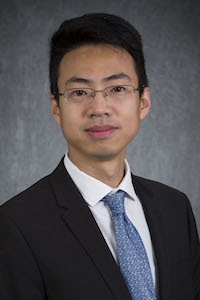 The Palais Outstanding Doctoral Student award is given to a graduating electrical engineering doctoral student who exemplifies excellence in research and academics. The award was established in 2003 with the generosity of Emeritus Professor Joseph Palais and his wife, Sandra Palais. Students are nominated by their doctoral advisors, must maintain at least a 3.75 grade point average and have at least one publication in a journal or at a conference to qualify.
The Palais Outstanding Doctoral Student award is given to a graduating electrical engineering doctoral student who exemplifies excellence in research and academics. The award was established in 2003 with the generosity of Emeritus Professor Joseph Palais and his wife, Sandra Palais. Students are nominated by their doctoral advisors, must maintain at least a 3.75 grade point average and have at least one publication in a journal or at a conference to qualify.
This year’s award went to Zhengshan “Jason” Yu.
While living in Shanghai, China, Yu noticed the poor air quality in winter due to vehicle emissions and the burning of fossil fuels as the country’s main energy source. The motivation to solve this environmental concern fueled Yu’s research interest in renewable energy.
“I’m passionate about solving energy problems,” said Yu, an international student from Jinhua, China. “I can use my skills to help generate the clean electricity we need.”
Yu has a bachelor’s degree in microelectronics and a master’s degree in integrated circuits from Shanghai University, both of which support his research endeavors in photovoltaics.
Currently, silicon solar cells dominate the photovoltaics market, representing 90 percent of solar panels available commercially. They offer the highest efficiency at the lowest cost but are reaching their practical efficiency limit. This could hinder the acceleration of solar energy in the renewable electricity market.
“I realized the silicon technology is approaching its theoretical efficiency limit,” said Yu, who successfully defended his thesis for a doctorate in electrical engineering and will graduate in May. “The only proven way to break this limit is called a tandem technology, in which a solar cell of another material is stacked on top of silicon to make more efficient use of the full solar spectrum.”
Yu conducts research under Zachary Holman, an assistant professor of electrical engineering. They seek to engineer a solar cell tandem technology that pairs silicon with perovskite — a cheap, easily manufactured photovoltaic material.
This solution could increase the conversion efficiency to greater than 30 percent, which surpasses the limiting efficiency of silicon solar cells alone at 27 percent. It could also achieve one of the U.S. Department of Energy’s SunShot 2030 goals, which will help make solar electricity costs competitive with conventionally generated electricity.
Yu has earned the Palais Outstanding Doctoral Student Award for his research on record-breaking efficiency for silicon-based solar cells.


